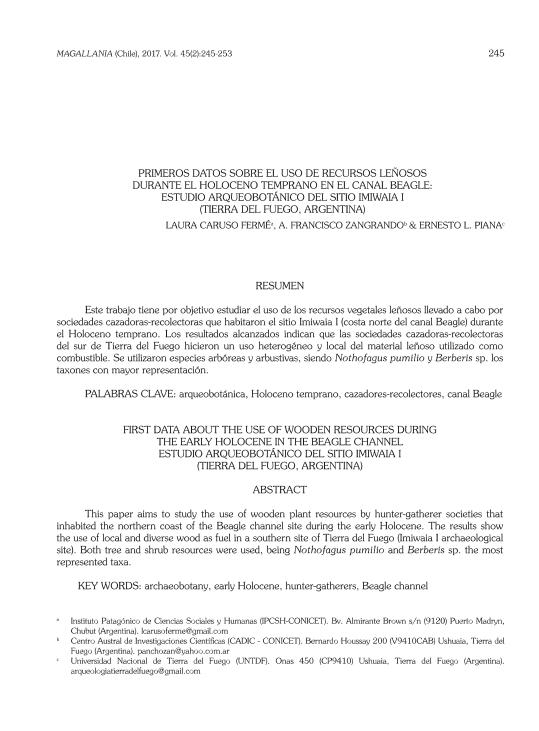Artículo
Este trabajo tiene por objetivo estudiar el uso de los recursos vegetales leñosos llevado a cabo por sociedades cazadoras-recolectoras que habitaron el sitio Imiwaia I (costa norte del canal Beagle) durante el Holoceno temprano. Los resultados alcanzados indican que las sociedades cazadoras-recolectoras del sur de Tierra del Fuego hicieron un uso heterogéneo y local del material leñoso utilizado como combustible. Se utilizaron especies arbóreas y arbustivas, siendo Nothofagus pumilio y Berberis sp. los taxones con mayor representación. This paper aims to study the use of wooden plant resources by hunter-gatherer societies that inhabited the northern coast of the Beagle channel site during the early Holocene. The results show the use of local and diverse wood as fuel in a southern site of Tierra del Fuego (Imiwaia I archaeological site). Both tree and shrub resources were used, being Nothofagus pumilio and Berberis sp. the most represented taxa.
Primeros datos sobre el uso de recursos leñosos durante el holoceno temprano en el Canal Beagle: estudio arqueobotánico del sitio Imiwaia I (Tierra del Fuego, Argentina)
Título:
First data about the use of wooden resources during the early holocene in the Beagle Channel estudio arqueobotánico del sitio Imiwaia I (Tierra del Fuego, Argentina)
Fecha de publicación:
12/2017
Editorial:
Universidad de Magallanes. Instituto de la Patagonia. Centro de Estudios del Hombre Austral
Revista:
Magallania (Punta Arenas)
ISSN:
0718-2244
Idioma:
Español
Tipo de recurso:
Artículo publicado
Clasificación temática:
Resumen
Archivos asociados
Licencia
Identificadores
Colecciones
Articulos(IPCSH)
Articulos de INSTITUTO PATAGONICO DE CIENCIAS SOCIALES Y HUMANAS
Articulos de INSTITUTO PATAGONICO DE CIENCIAS SOCIALES Y HUMANAS
Citación
Caruso Fermé, Laura; Zangrando, Atilio Francisco Javier; Piana, Ernesto Luis; Primeros datos sobre el uso de recursos leñosos durante el holoceno temprano en el Canal Beagle: estudio arqueobotánico del sitio Imiwaia I (Tierra del Fuego, Argentina); Universidad de Magallanes. Instituto de la Patagonia. Centro de Estudios del Hombre Austral; Magallania (Punta Arenas); 45; 2; 12-2017; 245-253
Compartir
Altmétricas




